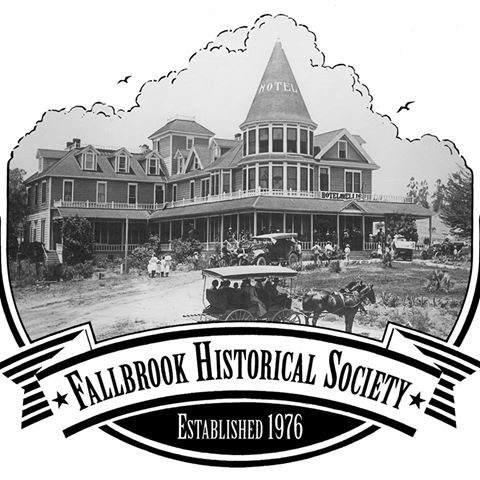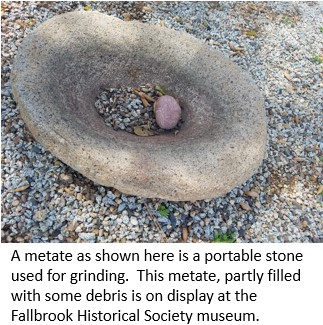Bedrock milling sites along Live Oak Creek are evidence of prehistoric activity in and around Fallbrook from hundreds of years, or even more, before the first European settlers arrived. One bedrock milling site of over 100 square feet is visible on the grounds of the Reche schoolhouse, alongside an old stream bed that is apparently a seasonal tributary of Live Oak Creek. The source of Live Oak Creek rises along the base of Red Mountain. This stream flows south roughly following today’s Live Oak Park Road, traveling through Live Oak Park, and continuing southward alongside today’s Gird Road to eventually feed into the San Luis Rey River.
The bedrock milling site at the Reche schoolhouse may have been known to the Reche settlers of this property back in 1870, but was only re-discovered in the late 20th century, when a volunteer work party of U.S. Marines were helping the Reche Club clear brush from the grounds of this community meeting place.
An even larger undated and unmapped bedrock milling site exists about a thousand yards downstream from the Reche schoolhouse at the San Diego County-owned Live Oak Park. This larger site apparently has also not been formally studied, even though the site has been fully accessible to the public for the past century.
Mortars were formed in the exposed bedrock by native women grinding acorns with stone pestles, gradually making indentations deeper and wider over centuries. The native women worked here by the creek, season after season, while watching their children, and teaching them the skills for preparing food. The acorn foods gathered from the live oak trees were nutritious and reliable from year to year. After grinding, the acorn meal was leached with water to remove the bitterness, then dried out, and sifted into flour. The coarsest flour was used for making bread, while the finer flour was used to make soup or mush.[1]
Acorns were a dietary staple. Acorns were typically gathered in the Autumn season by climbing a tree and hitting the branches with a pole to cause a shower of acorns to fall below where they could be gathered in baskets. One healthy oak was capable of producing 500 to 1,000 pounds of acorns.[2]
Native American hunters would have found the oak woodlands of California to be rich in game with rabbits and squirrels. Also deer, bear, and other wildlife thrived on the acorns and liked to pause in the shade of the Live Oak trees. Roots or seeds may also have been ground in these mortars. Chemical analysis may be able to determine the type or use of various mortars.
Although the exact age of these sites is yet to be determined, Native American cultures in Southern California had evolved and thrived among these woodlands for millennia. The Daisy Cave native site on San Miguel Island near Santa Barbara has been shown to be over 11,000 years old.[3] Radiocarbon dating efforts of other regional North San Diego County Inland sites, including nearby Camp Pendleton, suggest a period of human presence here may be shown to be from about 6500 B.C.[4]
Native Americans in the San Luis Rey Valley called themselves Payomkawichum, or “Western People”. When the Spanish missionaries arrived and established Mission San Luis Rey in 1798, the Spanish imposed the name San Luiseño, later shortened to Luiseño, upon the original inhabitants of the land due to their proximity to the Mission. There are 6 bands of the Luiseño. The Serranos and Gabrielenos bands to the north are the Tumamkawichum, “Northern People”. Likewise, the Cahuillas and Cupeños are the Kwiimkawichum, “Eastern People”. Pauma and Pala are the Payomkawichum or “Western People.” [5]
The milling station on the Reche schoolhouse grounds can be visited at 1319 S. Live Oak Park Rd when the schoolhouse is open to the public.
Tom Frew,
FHS Historian
References:
[1] University of California Berkeley.edu/outreach/teaching kit_pdf
[2] Robert F. Heizer, University of California Archaeological Survey.
[3] Prehistory of the Southern Bight by Brian F. Byrd and L. Mark Raab, Chapter 14 in California Prehistory, edited by Jones & Klar.
[4] Cultural Resources Study; Archaeological Survey, Testing, and Evaluation of Three Bedrock Milling sites, and Evaluation of One-Built Environment Resource for the Stonemark Estates Project in Unincorporated San Diego County, California by SWCA Environmental Consultants 2008.
[5] History of the Pauma Band of the Luiseño https://www.paumatribe.com/history/ .



